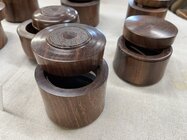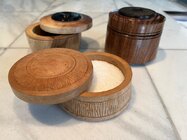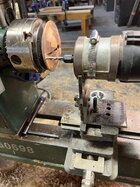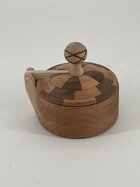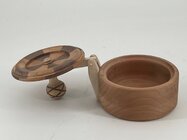Hmm, I just realized, I had never asked Claude.ai. I just did, and it gave me the term "miniature hidden pivot pin", which I then searched, and from some other site, I found that Lee Valley sells these:
Discover the Lee Valley Hidden Hinge Pins. Buy this product now on our Lee Valley online store.

www.leevalley.com
Looks like their intended purpose is a normal liftable box lid, but...if you used just one vertically, I wonder if it would work for your desired use case... I have a few salt wells that I purchased from, I actually don't recall now. They have, oh, I'd say, close to 1/2" thick walls, so pretty thick, and the lid is at least that thick. So a 1/4" mini hidden pivot pin might work for that.
EDIT:
Finished watching the video on that page. I think you would go without the spring. Further, I think to make it work for a salt well, you would probably want to either drill a hole small enough for a tight friction fit (maybe in the lid, so the pin is held fast in the lid and won't pivot there), then drill a slightly oversized hole in the rim of the well, and just slide the pin into that. You could adjust the diameter of that hole in the well wall, to control whether the lid spins open freely, or needs a little force to open. The latter might then offer the ability to keep the lid closed through a slight bit of friction, so it doesn't just swing open if you say move the salt well.


